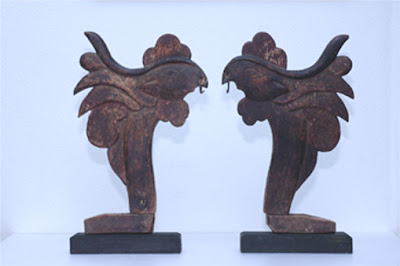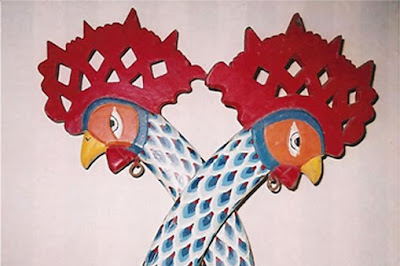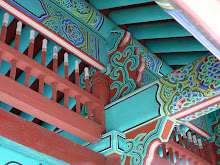
Seoul, like many international cities, is littered with museums; they are cultural, historical and even eclectic in nature and presentation. They are world-renowned (for example, the
National Museum of Korea), they are cultural (e.g. the
Kimchi Field Museum), and they are obscure (like the
Seoul Museum of Chicken Art). I typically appreciate national museums for their historical and cultural treasures, but I often can't be bothered by many others. Sometimes, however, the universe makes it so that you don't have a choice. If it is meant to be that you are to tour the Museum of Chicken Art, then you are to take the tour. And you will gain something from the experience, too.
For several weeks I had been waiting for December 4th to come around so I could take the afternoon off work and sit in on the English language lecture at the
Anguk Zen Center in northern Seoul. It is uncommon for me to leave work early and I felt like a bit of a truant as I took the subway to Anguk Station. I had a page from
Groove magazine in my pocket. On it was an advertisement and map to the center. In my anticipation of this day, I had folded and unfolded the page so often that the seams were flimsy, and seemingly delicate.
I followed the map out exit 2 and up the road, passed the middle school on my right, across the intersection, and passed the Catholic church on my left. The neighborhood was lovely. It was quieter than other neighborhoods and little shops sold scarves and sweaters, trendy clothes and handmade and locally designed pottery. I thought of my mom because she would have appreciated this part of the city and because we didn't venture here while she was visiting. It was my mom who found the magazine advertisement now crumpling in my hand.
Visiting a new part of a city you know a bit about is always a special experience. It's full of "Huh, I had no idea," surprises. I had no idea ceramics could be so beautiful and that they were so plentiful in Seoul. I had no idea there was a road that felt to me so much like home. I had no idea that there were so many Catholic nuns in Seoul. I had a vague idea that the Chicken Museum was in this area, so it wasn't a great surprise when I passed by the first time.
As it turns out, the building in which the Anguk Zen Center resides (or resided?) has no sign or placard identifying it to be the Zen Center. I only now this now because I found a picture of it online. Last Saturday I walked passed this building two of three times and asked employees in the neighboring ceramics shop if they had heard of the place or if they might know where it is. Nothing.
It is not uncommon that something advertised in Seoul is no longer there. Restaurants, service businesses, and institutes are known to disappear or relocate with little or no notice at all. So I easily decided to do something else with my day. I started walking in the direction from which I came, and that is wen I passed the Chicken museum again.
I stood outside of the building for several seconds, wondering why one might create a museum for chickens. I am sure every creature under the sun is worthy of a museum all its own, but chicken art simply sounds funny in my mind and off my tongue. I couldn't pass up the opportunity to answer my question. I was meant to learn about chickens on this very day.
The entrance fee is 3,000 won for adults, and I was greeted upon entering the first gallery, and escorted upstairs to the second gallery--this is where the tour begins. I was then greeted by the curator, who led me through the museum. This was fine. I should feel honored--I do a little bit-- that the curator spent this time with me, but his English was difficult to understand and I think he only told me what was written on the poster boards next to each exhibit. He sort of rushed me through the many sculptures of chicken heads and paintings of chickens and peonies, cedar trees, and other representative foliage. I may have liked to take more time taking in all of the chicken history, but he seemed to be on a schedule.
So what did I learn about the chicken? Well first off, I learned that Korea respects and appreciates the chicken, but mostly Korea reveres the rooster. The rooster's five virtues are much sought after by Korean men: Intelligence, Strength, Courage, Heartedness, Trust. The rooster is intelligent because it wears that lovely crown. The traditional hat worn by government officials in Korea is named after the chicken's crown. The rooster's sharp and fierce talons represent his strength. The rooster will fight without running away, and this is representative of his courage. The tiger, I was reminded, will run away from a fight. (Wuss!) The rooster has what

is called heartedness because he cries when he finds food. Instead of gobbling it all up for himself, he lets his family know that it is there so they can have some, too. Finally, we can always count on the rooster to cry out at dawn and this is our reason for trusting him.
A rooster and hen chicken represent fertility when shown together, and chicks added to the mix make this message stronger. A rooster in a peony (seen at left) will bring wealth and fame--this is popularly represented in traditional art and may be a gift from a bride's parents to their new son-in-law. Similarly, a rooster in a Cockscomb brings a successful career.
The entire second floor gallery is dedicated to Korean traditional chicken art. Traditional Korean coffins include wood carved sculptures called 'Kokdu' at the corners, and these sculptures are often in the shape of chicken heads. The chicken happens to be the only one of twelve Chinese zodiac animals that has wings, and so it serves as a messenger between this world and the next. It also wards off evil spirits. The museums collection of chicken Kokdu is quite extensive and they represent a great variety of styles and influences. Some are more than a hundred years old.



I learned a lot about the place of the chicken in Korean history and culture. The gallery has pieces that tie the chicken to the Shamanic God of fortune, it includes furniture carved with chickens or the heads of chickens, and it shares some history of how the chicken was used in protecting the spirits of the dead.
The first floor gallery houses a collection of chicken art from around the world. And as you may imagine, everyone has something to share when chickens are the focus. From Scandinavia to Africa, Myanmar to native American North America, and from South America to Japan, everyone has turned something into a chicken. Wood, brass, crystal, ceramic, recycled plastic bags, you name it, there was a chicken made out of it. There were chicken pairs and families, chicken tea sets and paintings, chickens sitting, chickens crowing, chickens pecking and chickens simply standing about. There was little history shared here, but one thing was clear: the chicken is revered everywhere.
I had set out seeking a lecture about Zen meditation, but my path was not as direct as I had expected it to be. I suppose I can take this experience as my lesson in Zen anyhow. Too strong an expectation may lead to a frustration so great that the opportunity that is truly available on this path may be missed. And if that were the case, how would I learn what snippet of wisdom the Museum of Chicken Art had to offer? Well, I wouldn't.
 The evening ended with a walk home after a quick visit to a local temple. The lanterns were welcoming and the fact that there were no other people in the golden room of the temple made it the quietest place I've experienced in Seoul--I could have stayed for hours.
The evening ended with a walk home after a quick visit to a local temple. The lanterns were welcoming and the fact that there were no other people in the golden room of the temple made it the quietest place I've experienced in Seoul--I could have stayed for hours.










